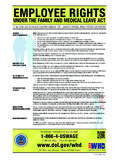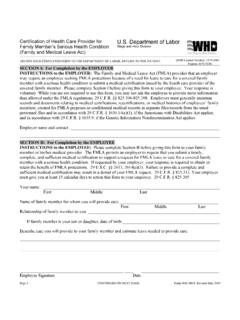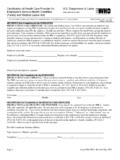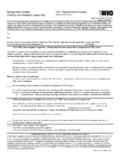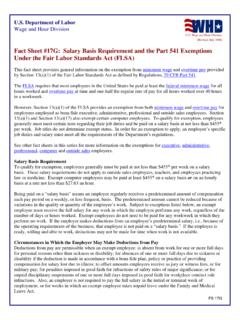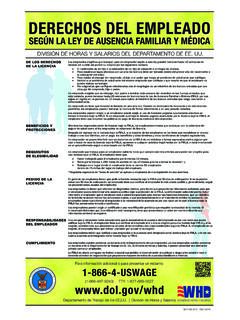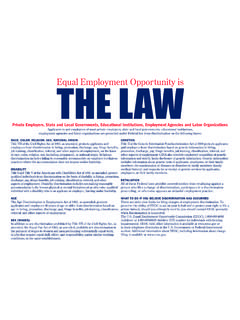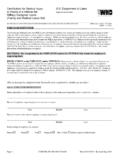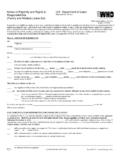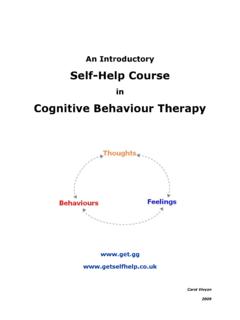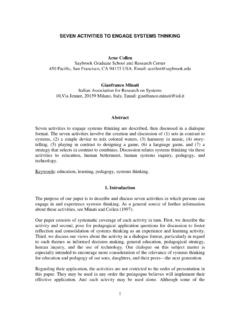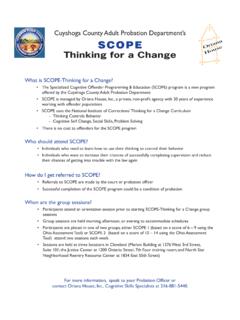Transcription of Problem Solving and Critical Thinking
1 Skills to Pay the Bills98 Problem Solving and Critical ThinkingEveryone experiences problems from time to time. Some of our problems are big and complicated, while others may be more easily solved. There is no shortage of challenges and issues that can arise on the job. Whether in an office or on a construction site, experiencing difficulties with the tasks at hand or with co-workers, the workplace presents ongoing challenges on a daily basis. Whether these problems are large or small, they need to be dealt with constructively and fairly. Having the necessary skills to identify solutions to problems is one of the skills that employers look for in say they need a workforce fully equipped with skills beyond the basics of reading, writing, and arithmetic to grow their businesses. These skills include Critical Thinking and Problem Solving , according to a 2010 Critical Skills Survey by the American Management Association and Solving and Critical Thinking refers to the ability to use knowledge, facts, and data to effectively solve problems.
2 This doesn t mean you need to have an immediate answer, it means you have to be able to think on your feet, assess problems and find solutions. The ability to develop a well thought out solution within a reasonable time frame, however, is a skill that employers value greatly. Employers want employees who can work through problems on their own or as an effective member of a team. Ideal employees can think critically and creatively, share thoughts and opinions, use good judgment, and make decisions. As a new employee, you may question why an organization follows certain steps to complete a task. It may seem to you that one of the steps could be eliminated saving time, effort, and money. But you may be hesitant to voice your opinion. Don t be; employers are usually appreciative when new employees are able to offer insight and fresh perspective into better and more efficient ways of doing things.
3 It is important to remember, however, that as someone new to the organization, you may not always have the full picture, and thus there may be factors you are unaware of that dictate that things be done in a particular way. Another important thing to remember is that when you are tasked with Solving a Problem , you don t always need to answer immediately. The activities in this section focus on learning how to solve problems in a variety of ways in the workplace. Participants will hear about how to properly tell the difference among criticism, praise, and feedback and reacting appropriately. The section will also review strategies for making ethical decisions, Solving problems on a team with others, and learning how to take into account others perceptions when assessing actions or statements in the note to facilitators: Building self-determination skills, such as goal setting, decision-making, self-advocacy, and Problem Solving should be included in career planning for all youth.
4 Youth with disabilities and/or other (perceived) barriers to employment and/or disconnected youth will tend to have a resiliency not always experienced by their same aged peers and not always easily seen or understood by themselves or by adults. You are encouraged to use the activities in this section to help young people explore how the obstacles they (or those they know) may face in life can pose an opportunity for developing and demonstrating maturity, responsibility, and wisdom. Providing young people with safe opportunities to explore how their personal resiliency can be used to develop enhanced Problem Solving and conflict resolutions skills is a opportunity many adults may shy away from, but one that may ultimately be a Soft Skills for Workplace Success 9921. Praise, Criticism, or FeedbackJUST THE FACTS: In a work setting, we give and receive many different types of information.
5 The purpose of this activity is to help participants determine the differences between criticism, praise, and feedback not only how to offer it, but how to receive it as well. Time20 minutes Materials DirectionsDiscuss the difference between praise, criticism, and feedback and ask participants for examples of each. Praise: an expression of approval Criticism: an expression of disapproval based on perceived mistakes or faults Feedback: information about a person s performance of a task used primarily as a basis for improvementDivide the group into pairs of two. Read the following statements aloud one at a time. It is suggested that the facilitator use different voice tones to truly help participants differentiate the intended meaning of each sentence (which, by the way, can certainly vary). After each statement, give each pair 10 seconds to decide whether the statement is criticism, praise, or feedback.
6 Someone from each team should hold up the card that represents a collective decision. If chart paper and sentence strips were used, participants could move around the room to match each statement to what they believe to be the correct Mr. Jones told me how much he appreciated your thank you note after the job interview. He thought it was a great personal Your desk is such a mess. Are you sure you are not trying to grow your own paper?3. I noticed that you ve been coming in late the last couple of How many times do I have to tell you how to file these documents?5. You look great It would work better for me if I could explain my version of the story out loud before you ask questions. One set of Praise | Criticism | Feedback cards for each group. Alternatively, you might choose to hang three pieces of chart paper each with one of the words on it.
7 Slips of paper could be made with the statements below. Skills to Pay the Bills1007. You ve improved a lot this I found it difficult to evaluate this resume because it was I liked it much better when we got to choose the projects instead of being assigned to the larger group, discuss the different ways people may react or respond differently to praise, criticism, and feedback. It is inevitable that we will all receive criticism at some point on the job, and the way in which we respond can impact our own attitude and the attitudes of those with whom we work. Discuss with the group how they, personally, respond differently to praise vs. feedback vs. criticism. ConclusionTake the opportunity to rephrase the way in which any of the above statements were made. How might rephrasing get a different response or reaction? If you had to make a rule for how you would like to receive feedback and criticism, what would that rule be?
8 Journaling ActivityHow does it make you feel when others criticize the work you do? Are you able to respond to feedback differently? Think about a time when you criticized someone else. What happened? How did that situation ultimately make you feel? Extension ActivityOften times, the inability to give and/or receive criticism and feedback might cause conflict in the workplace. Reach out to the National Institute for Advanced Conflict Resolution ( ) to find local, no-cost training opportunities or workshops for participants. You might also try your state or county s mediation center (often connected to juvenile services) to see what programs are offered. Mastering Soft Skills for Workplace Success 101 PRAISECRITICISMFEEDBACKS kills to Pay the Bills10222. Workplace EthicsJUST THE FACTS: We all have our own set of values or standards of behavior that we operate by on a daily basis.
9 However, we may not always feel we can apply these same principles or standards while at work. The purpose of this lesson is to help participants learn some of the steps necessary to make ethical decisions on the job. Time30 minutesMaterialsDirectionsAsk participants the following questions and discuss answers with the group: How do you make decisions? Is decision-making a skill that was taught to you? Do you have personal rules for decision-making? If you have rules, do these rules change if you are making decisions at home, at school, with friends, or at work? Now, let s discuss ethics. What are ethics? [Possible answer to be discussed: a set of (often unspoken and generally understood) moral principles relating to a specified group, field, or form of conduct; a group of moral principles, standards of behavior, or set of values regarding proper conduct in the workplace].
10 Ethics on the job often deal with a code of conduct or a set of principles for BOTH the employer and the employee. Ask for and offer some examples of workplace ethics from both the EMPLOYER and the EMPLOYEE. For example: A list of work ethics for an employer or a company might be: To provide a safe work environment for staff and employees To treat employees with dignity and respect To provide a fair wage for the services rendered To handle all business transactions with integrity and honesty Activity 22 one copy for each participant (or group). These materials were adapted from Lesson Planet: Tools For Success: A Study in Employer/Personnel Issues, Ethics, and Professional Behavior (Alabama Learning Exchange)Mastering Soft Skills for Workplace Success 103A list of work ethics for an employee might include: To show up on time To tend to company business for the whole time while at work To treat the company s resources, equipment, and products with care To give respect to the company; that means honesty and integrityAsk the group what types of ethical issues might come up at work?
